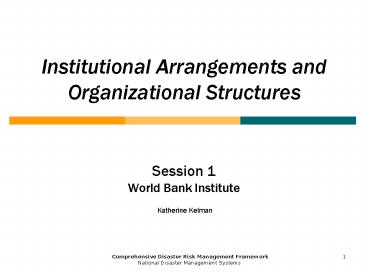Comprehensive Disaster Risk Management Framework National Disaster Management Systems
1 / 12
Title:
Comprehensive Disaster Risk Management Framework National Disaster Management Systems
Description:
Title: Organizational and Institutional Arrangements of National Disaster Management Systems Author: Denise Froning Last modified by: wb326993 Created Date –
Number of Views:934
Avg rating:1.0/5.0
Title: Comprehensive Disaster Risk Management Framework National Disaster Management Systems
1
Institutional Arrangements and Organizational
Structures
- Session 1World Bank Institute Katherine Kelman
1
1
1
1
2
How are National Disaster Management Systems
Organized?
- Maintain formal and informal interaction
between institutions, financial
mechanisms, regulations and policies - Engage senior government policymakers AND
accommodating and supporting local
decision-making and private market
initiatives - Balance centralized (top-down) and
decentralized (bottom-up) approaches
2
3
How are National Disaster Management Systems
Organized? contd.
- Address both the ex ante (pre-disaster) and ex
post (post-disaster) phases of the risk
management cycle - However, they demand distinct technical and
administrative approaches. - Tailor organization to the nature of federal or
intergovernmental relations within the country. - National governments usually play a major role in
risk identification, risk transfer, and
rehabilitation and reconstruction. - Local governments, often with the help of NGOs,
are involved in risk mitigation, preparedness and
emergency response.
3
4
Building and Strengthening National Systems for
Disaster Prevention and Response
- An integrated, cross-sectoral network of
institutions addressing all the phases of
risk reduction and disaster recovery
requires - Policy and planning
- Reform of legal and regulatory frameworks
- Coordination mechanisms
- Strengthening of participating institutions
- National action plans for mitigation policies,
and institutional development. - The organizational approach is also important
- Reactive vs. proactive approach to risk
management. - Powers and responsibilities concentrated in
center vs. hierarchically distributed. - Interaction between the levels coercive vs.
cooperative.
4
5
Designing Effective National Disaster Management
Systems
- Have an explicit national disaster strategy that
is integrated into other national policies,
such as - Environmental, poverty, development
- Integrate key players in the national disaster
management process, such as - Finance ministry, local community leaders, NGOs,
and private market actors - Make provisions to ensure sufficient resources
for key players to carry out their
responsibilities, such as - Continual risk assessment
- Country-wide risk transfer
- Mutual aid agreements with other levels of
government - Extended partnerships
5
6
Philippines - Elements of An Effective Response
Operation
COMMAND AND CONTROL
LAW ENFORCEMENT
EVACUATION AND RELIEF
EMERGENCY MEDICAL SERVICES
FIRE SUPPRESSION
SEARCH AND RESCUE
DAMAGE AND NEEDS ASSESSMENT
VOLUNTEER RESPONSE GROUPS / AUXILLIARIES
6
7
Typical Organizational Structure
7
8
Country Approaches to Disaster Management Systems
- Risk management receives the attention of those
responsible for long-term economic planning and
is integrated into the planning process when - Disasters are considered as part of the
development process - Ineffective systems fail to develop long-term
sustainable support for members activities - Successful systems take advantage of the existing
government structures and involve - National, provincial, local, and community
government - Ministries and other institutions
8
9
Incorporating Key Players Is Important
- Finance ministries
- Help ensure funding for the institutional
framework - Facilitate incorporation of disaster management
into development policy - Provide incentives for financing mitigation
projects. - Communities
- Local communities provide impetus for national
disaster management when political motivation
flags - Local level feedback is important in the disaster
management process. - International aid and financial institutions
- Policies and the incentives they create for
countries can make or break the establishment of
national disaster risk programs.
9
10
Incorporating Key Players, contd.
- Private sector risk transfer providers
- Provide individuals and communities with a range
of options for transferring disaster risk ex-ante
through insurance, catastrophe hedges, etc. - Create incentives for mitigation and prevention
- Can team up with governments to devise affordable
insurance schemes - Military
- Traditionally in control of civil defense
10
11
Philippines National Disaster Coordinating
Councils ORGANIZATIONAL NETWORK
NATIONAL DISASTER COORDINATING COUNCIL
17 REGIONAL DISASTER COORDINATING COUNCILS
79 PROVINCIAL DISASTER COORDINATING COUNCILS
113 CITY DISASTER COORDINATING COUNCILS
1,496 MUNICIPAL DISASTER COORDINATING COUNCILS
41,956 BARANGAY DISASTER COORDINATING COUNCILS
11
12
Becoming Integrated into Policies and National
Systems
- Requires political will
- Requires a constituency beyond disaster
specialists - Needs to reflect the preferences of the
population, such as when legislated through a
participatory process - Needs to reflect correctly assessed risks through
cooperation with researchers
12































